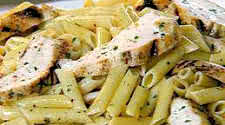Pasta & Bodybuilding - Using Carbohydrates as a Exercise Fuel Source

Fuel your Body with Key Nutrients for Great Results
If one food were to be singled out as being universally loved, it would probably be pasta. Pasta is found in some form or other in
almost every culture, and has a history dating back to the middle ages. The old war story of Marco Polo bringing pasta from China
to Italy (for the first time) has been disproved, but it remains a part of the food's colorful past.
Pasta long ago became an integral part of the Italian diet. It was a cheap, filling and nutritious food to eat. The variety of
sizes and shapes provides almost infinite combinations. In Italy there are over 300 playful names for 100 pasta shapes.
Nutritionally, pasta is rich. It is basically composed of semolina flour (ground from hard durum wheat) and water. Two ounces of
uncooked pasta (five ounces cooked) provide eight grams of protein, one gram of fat and 42 grams of carbohydrates. The carbs are
key. Your body relies on them for all vigorous activity. Carbs are broken down into glucose, which is used as a main energy fuel.
If you don't consume enough carbohydrates your body is forced to run on fat and protein, instead of utilizing them for building
and replacing body tissues. The reality of it is that if you don't consume enough carbs you will simply run out of energy. The
organizers of the New York City Marathon realized this many years ago, and pre-marathon spaghetti dinners quickly became a
tradition.
Besides their abundance of carbohydrates, pasta is also a great source of protein (semolina flour is 13 percent protein) as well
as other nutrients. As for calories, ounce for ounce pasta provides the same amount as pure protein (such as meat) with half the
fat. The Italian tradition of combining pasta with sauces containing small amounts of animal or fish protein and low amounts of
fat provides wonderfully healthy and filling meals.
Italian pasta basically comes in two varieties. The first-pasta secca or dried pasta, is composed of semolina flour and water. It
is yellow in color (before cooking) and has a nutty flavor. When cooked al dente or "to the tooth," it has a nice chewy bite to it.
Dried thin pastas (like spaghetti, fettucine and ca-pellini) are used with olive oil based sauces. Dry pasta has the ability to
absorb a lot of sauce without becoming mushy. Dried tubular shapes (shells, penne and fusil I i) trap sauces with bits of meat and
vegetables. For a general rule, use thicker pastas with thicker sauces.
Fresh pasta or pasta all'uovo is composed of unbleached flour or semolina flour, water and eggs. For some reason it has gotten the
undeserved reputation of being better than dried pasta. Fresh pasta is more delicate in texture and tender to the bite. It is very
well suited to cream and butter-based sauces and rich cheeses. Making your own fresh pasta is a bit time consuming but very
rewarding. However, if you are watching your egg consumption you might want to stick to dried pasta.
Additions to pasta (both fresh and dried) run the gamut, from whole wheat and buckwheat to spinach and squid ink. Shapes start at
tiny pastina (for soups) and end with wide tender lasagna noodles.
To cook pasta properly, start with a large pot and four to five quarts of water (for one pound of pasta.) Cover it, and over a high
flame, bring to a full boil. Add one tablespoon of salt and ease in the pasta. Stir well to prevent sticking and cover the pot to
bring it back to a boil. Remove the cover and stir again (keep stirring it from time to time-pasta stuck together is a real drag to
eat). Start testing dry pasta for doneness after five minutes. It should take anywhere from five to 10 minutes. The way to test pasta
is easy--simply fish out a piece and bite into it. It's done when it has a slight firmness (not crunch!) in the center. Fresh pasta
takes from less than a minute for very thin spaghetti to up to seven minutes for larger shapes. Fresh pasta is done when it has lost
its rubbery quality. When you've decided it's cooked, quickly pour the pasta into a colander set in the sink. Throw it back in the
pot or in a serving dish and toss it with a little sauce or olive oil (or butter) to prevent sticking. The only time you should
rinse pasta is when you are planning to make a salad out of it. The following original recipes are low on fat but high on flavor.
Bon appetit!